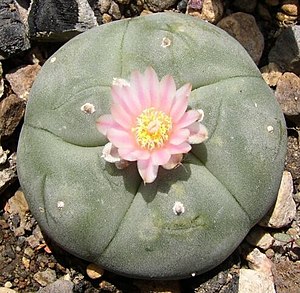Lophophora
| Lophophora | ||||||||||||
|---|---|---|---|---|---|---|---|---|---|---|---|---|

Lophophora williamsii |
||||||||||||
| Systematics | ||||||||||||
|
||||||||||||
| Scientific name | ||||||||||||
| Lophophora | ||||||||||||
| JMCoult. |
Lophophora is a genus of plants from the cactus family(Cactaceae). The botanical name of the genus is derived from the Greek words λόφος (lophos) for 'head of hair' and φόρά (phora) for '(to) carry'. He refers to the areoles of the plantsthat carry tufts of wool.
description
The species of the genus Lophophora grow low and almost geophytic and often form groups with numerous, densely packed shoots . The blue-green, yellow-green or sometimes reddish-green shoots are mostly flattened, spherical with a sunken tip. They reach heights of growth of 2 to 7 centimeters and diameters of 4 to 12 centimeters. The often distinct, vertical ribs consist of low and rounded or hump-like humps. A tuft of soft, yellowish or whitish wool hairs emerges from the areoles on the tips of the cusps . There are no thorns .
The flowers appearing between the areoles on the shoot tip are white to slightly pink or yellowish white, sometimes also reddish. They open during the day, are 1 to 2.4 centimeters long and reach a diameter of 1 to 2.2 centimeters. Your pericarpel is bald.
The club-shaped to elongated, fleshy fruits are glabrous and more or less pink-red. When ripe they turn brownish whitish and dry. The fruits cannot be torn open and are 1.5 and 2 centimeters long. They contain black, pear-shaped, humped seeds that are 1 to 1.5 millimeters long and 1 millimeter wide.
Systematics and distribution
The genus Lophophora is distributed in the United States in the state of Texas and in northeast and central Mexico .
The Spaniard Francisco Hernandez de Toledo gave a first description of the plants under the name Peyotl , which was only published in 1790 and went unnoticed in Europe. Joseph zu Salm-Reifferscheidt-Dyck described the species Echinocactus williamsii in 1845 . Charles Lemaire had previously used the species name in a catalog. The first description of the genus Lophophora was published in 1894 by John Merle Coulter . The type species of the genus is Echinocactus williamsii .
The genus includes the two types:
- Lophophora diffusa (Croizat) Bravo
- Lophophora williamsii (Lem. Ex Salm-Dyck) JMCoult.
proof
literature
- Edward F. Anderson : The Great Cactus Lexicon . Eugen Ulmer KG, Stuttgart 2005, ISBN 3-8001-4573-1 , p. 358-359 .
Individual evidence
- ↑ De Historia Plantarum Novae Hispaniae . Book 15, 1790, p. 70, (online) , p. 70 (PDF; 318 kB)
- ↑ Joseph zu Salm-Reifferscheidt-Dyck: Description of some new cacti which are cultivated in the Princely Salm-Dyck'schen garden . In: General garden newspaper . Volume 13, Number 49, 1845, pp. 385-386, (online) .
- ^ John Merle Coulter: Preliminary revision of the North American species of Cactus, Anhalonium and Lophophora . In: Contributions from the US National Herbarium . Volume 3, 1894, p. 131, (online) .
- ^ Edward F. Anderson : The great cactus lexicon . Eugen Ulmer KG, Stuttgart 2005, ISBN 3-8001-4573-1 , p. 358-359 .
further reading
- Edward F. Anderson: The biogeography, ecology, and taxonomy of Lophophora (Cactaceae) . In: Brittonia . Volume 21, No. 4, Springer, New York 1969, pp. 299-310, doi : 10.2307 / 2805756
- Edward F. Anderson: Peyote: The Divine Cactus . Arizona 1996. ISBN 0-8165-1654-5
- GD Rowley: Lophophora - species and cultivars . In: CactusWorld . Volume 24, number 4, 2006, pp. 201-209, PDF .
Web links
- Edward F. Anderson: Botany of Peyote from Peyote: The Divine Cactus
- Page of a Lophophora collector